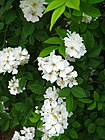Note: This is a project under development. The articles on this wiki are just being initiated and broadly incomplete. You can Help creating new pages.
Rosa multiflora
Rosa multiflora is a deciduous shrub that can grow up to 5.00 metres tall. It is harvested from the wild for local use as a food, medicine and source of materials.
Contents
- 1 Uses
- 2 Parts Used
- 3 Chemical Composition
- 4 Common names
- 5 Properties
- 6 Habit
- 7 Identification
- 8 List of Ayurvedic medicine in which the herb is used
- 9 Where to get the saplings
- 10 Mode of Propagation
- 11 How to plant/cultivate
- 12 Commonly seen growing in areas
- 13 Photo Gallery
- 14 References
- 15 External Links
Uses
Sores, Constipation, Articular pain, Ulcers, Wounds, Sprains, Injuries, [[:Category:Ayurvedic Herbs known to be helpful to treat |]], [[:Category:Ayurvedic Herbs known to be helpful to treat |]], [[:Category:Ayurvedic Herbs known to be helpful to treat |]], [[:Category:Ayurvedic Herbs known to be helpful to treat |]].[1]
Parts Used
Fruits, Seeds, Young leaves, Young shoots.
Chemical Composition
The fruit of many members of this genus is a very rich source of vitamins and minerals, especially in vitamins A, C and E, flavanoids and other bio-active compounds.[2]
Common names
| Language | Common name |
|---|---|
| Kannada | |
| Hindi | |
| Malayalam | |
| Tamil | |
| Telugu | |
| Marathi | |
| Gujarathi | |
| Punjabi | |
| Kashmiri | |
| Sanskrit | |
| English |
Properties
Reference: Dravya - Substance, Rasa - Taste, Guna - Qualities, Veerya - Potency, Vipaka - Post-digesion effect, Karma - Pharmacological activity, Prabhava - Therepeutics.
Dravya
Rasa
Guna
Veerya
Vipaka
Karma
Prabhava
Habit
Identification
Leaf
| Kind | Shape | Feature |
|---|---|---|
Flower
| Type | Size | Color and composition | Stamen | More information |
|---|---|---|---|---|
| {{{5}}} |
Fruit
| Type | Size | Mass | Appearance | Seeds | More information |
|---|---|---|---|---|---|
Other features
List of Ayurvedic medicine in which the herb is used
Where to get the saplings
Mode of Propagation
Seeds, Cuttings of half-ripe wood, Cuttings of mature wood, Air layering, Division of suckers.
How to plant/cultivate
Succeeds in most soils, preferring a circumneutral soil and a sunny position. Grows well in heavy clay soils. Succeeds on poor soils. Dislikes water-logged soils.[4]
Commonly seen growing in areas
Photo Gallery
References
- ↑ Indian Medicinal Plants by C.P.Khare
- ↑ Chemical constituents
- ↑ [Morphology]
- ↑ Cultivation
External Links
- Ayurvedic Herbs known to be helpful to treat Sores
- Ayurvedic Herbs known to be helpful to treat Constipation
- Ayurvedic Herbs known to be helpful to treat Articular pain
- Ayurvedic Herbs known to be helpful to treat Ulcers
- Ayurvedic Herbs known to be helpful to treat Wounds
- Ayurvedic Herbs known to be helpful to treat Sprains
- Ayurvedic Herbs known to be helpful to treat Injuries
- Ayurvedic Herbs known to be helpful to treat
- Herbs with Fruits used in medicine
- Herbs with Seeds used in medicine
- Herbs with Young leaves used in medicine
- Herbs with Young shoots used in medicine
- Habit - Deciduous shrub
- Index of Plants which can be propagated by Seeds
- Index of Plants which can be propagated by Cuttings of half-ripe wood
- Index of Plants which can be propagated by Cuttings of mature wood
- Index of Plants which can be propagated by Air layering
- Index of Plants which can be propagated by Division of suckers
- Herbs that are commonly seen in the region of On slopes
- Herbs that are commonly seen in the region of On scrub
- Herbs




